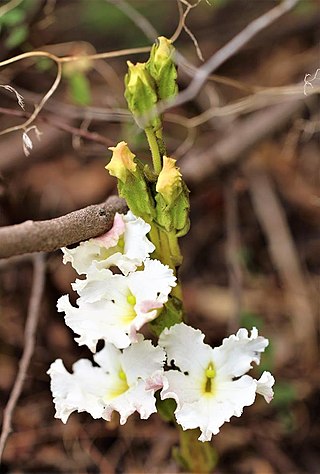
Orobanchaceae, the broomrapes, is a family of mostly parasitic plants of the order Lamiales, with about 90 genera and more than 2000 species. Many of these genera were formerly included in the family Scrophulariaceae sensu lato. With its new circumscription, Orobanchaceae forms a distinct, monophyletic family. From a phylogenetic perspective, it is defined as the largest crown clade containing Orobanche major and relatives, but neither Paulownia tomentosa nor Phryma leptostachya nor Mazus japonicus.

Cryptobiosis or anabiosis is a metabolic state in extremophilic organisms in response to adverse environmental conditions such as desiccation, freezing, and oxygen deficiency. In the cryptobiotic state, all measurable metabolic processes stop, preventing reproduction, development, and repair. When environmental conditions return to being hospitable, the organism will return to its metabolic state of life as it was prior to cryptobiosis.

A resurrection plant is any poikilohydric plant that can survive extreme dehydration, even over months or years.

Torenia is a genus of plants now classified in the family Linderniaceae. Torenia has also been classified in the figwort family Scrophulariaceae. Often called wishbone flowers, bluewings; in Hawaii nanioola'a or ola'a beauty, some species are grown as garden plants. Many F1 and F2 Torenia hybrids have been hybridized in the last 30 years. Colors can range from white with yellow throats to violet, blue, cobalt, lavender and purple.

Linderniaceae is a family of flowering plants in the order Lamiales, which consists of about 25 genera and 265 species occurring worldwide. Vandellia micrantha is eaten in Laos, but tastes bitter. Best known are the wishbone flowers Torenia fournieri and Torenia thouarsii, which are used as bedding plants, especially in the tropics. Micranthemum is sold as an aquarium plant under the name 'baby tears'.

Harveya is a genus of parasitic plants in the family Orobanchaceae. The approximately 29 species included are native to Africa from Eritrea to South Africa, Madagascar and the Mascarene Islands, the Arabian Peninsula, and Turkmenistan in Central Asia. In South Africa they are commonly known as 'inkblom', because early settlers used the flowers to make ink, and this is the source of the English common-names for the genus of ink flower or ink plant.

The genus Lindernia is a group of plants in the family Linderniaceae. They are native to warm regions in both the Eastern and Western Hemisphere.

Craterostigma plantagineum, is a resurrection plant species in the genus Craterostigma. It is a dwarf growing plant and can be found to make a 'carpet' across the ground, with blooms in shades of blue and purple. It is a well-studied desiccation-tolerant species known for its extreme vegetative tolerance against dehydration and desiccation. It is native to parts of Africa and to India. It is known as a resurrection plant.

Alectra is a genus of flowering plants in the family Orobanchaceae. It comprises hemiparasitic species which occur in tropical and southern Africa, including Madagascar, and tropical and subtropical Asia.
Bardotia is a genus of flowering plants belonging to the family Orobanchaceae.

Bonnaya is a genus of flowering plants belonging to the family Linderniaceae.
Crepidorhopalon is a genus of flowering plants belonging to the family Linderniaceae.

Dopatrium is a genus of flowering plants belonging to the family Plantaginaceae.
Micranthemum is a genus of flowering plants belonging to the family Linderniaceae.
Stemodiopsis is a genus of flowering plants belonging to the family Linderniaceae.
Sopubia is a genus of flowering plants belonging to the family Orobanchaceae.
Hartliella is a genus of flowering plants belonging to the family Linderniaceae.

Linderniella is a genus of flowering plants belonging to the family Linderniaceae.

Vandellia is a genus of flowering plants belonging to the family Linderniaceae. It comprises about 52 species.













